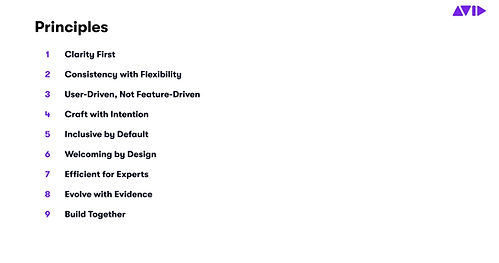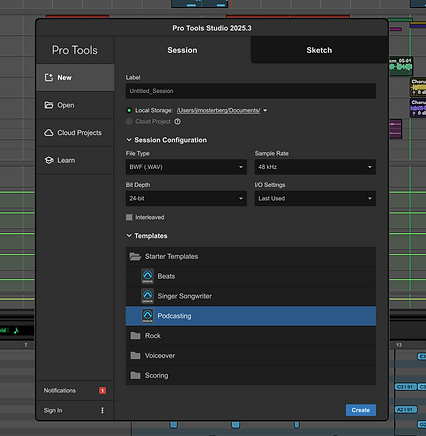
Leading Design Transformation at Avid
Executive Summary
This case study outlines my work leading a multi-year design operations transformation at Avid Technology. I unified a fragmented design organization, defined shared design principles, introduced a scalable UI library system, and implemented atomic and semantic design standards. I gained executive sponsorship through self-initiated service design work, led cross-product alignment efforts, and built technical proof-of-concepts to demonstrate design-to-code integration. These efforts laid the foundation for a more cohesive, efficient, and modern product design practice across Avid’s professional creative tools.
I currently hold the title of Lead Visual Designer, but functionally operate at the level of a Design Director - reporting directly to the Chief Product Officer, influencing org-wide UX strategy, and guiding systems-level transformation across teams.
Introduction
When I joined Avid, I found myself at the intersection of legacy tools, siloed teams, and a fragmented design culture. What followed was a multi-year effort to transform design operations-introducing shared tools, building a cross-functional design community, modernizing UI foundations, and aligning on scalable systems. What started as a push for incremental modernization became a reflection on strategy, resources, and the risk of fragmentation without a shared design vision.
Context
Avid is a household name in the world of video and audio production, producing industry-standard tools like Pro Tools, Media Composer, Sibelius and MediaCentral. These products have existed for decades, and with them came legacy design practices and deeply entrenched silos.
Shortly after joining, I discovered that many designers didn’t know each other. Product teams barely communicated. There was no centralized design asset repository. Different teams used different tools: Sketch, Figma, Adobe Illustrator. It was clear that to modernize our products, we first needed to modernize our design operations.
Phase 1: Retooling for Collaboration
We selected Figma as our official design tool and successfully onboarded the entire organization with help from the UX Ops team. I led multiple workshops and 1:1 onboarding sessions. Adoption was quick and largely frictionless.
Phase 2: Building a Design Community
To go beyond tooling, I initiated a Design Committee, bringing together design leads across the organization to align, share pain points, and explore opportunities. This small committee evolved into the Avid Design Community - a broader forum where designers share work, request feedback, and align on standards. This shift started to erode the deep design silos.
Phase 3: Aligning on Core Design Principles
As our design community began to grow, we needed a shared compass to guide design decisions across product teams. I led a collaborative effort to define and align around 9 core design principles, each serving as a north star for usability, inclusion, craft, and cohesion.
These principles are now referenced by designers and engineers alike when evaluating new features, reviewing designs, or discussing trade-offs.


Our 9 guiding principles, co-created with design community input and shared across the organization.
Phase 4: Evangelizing Atomic Design Principles
We introduced atomic design principles through live sessions and hands-on demos in Figma. Brad Frost was invited to present to our product organization. I showcased how one small component change could cascade through high-fidelity prototypes to promote reuse, efficiency, and consistency.
Phase 5: Gaining Executive Buy-In Through Service Design
My trajectory as a design leader at Avid accelerated when I independently created a Service Blueprint for the Pro Tools first-time user onboarding experience. I mapped the full user journey based on existing UXR data, highlighting peaks and valleys in user sentiment. I also engaged backend owners across technical and non-technical teams to capture backstage activities and dependencies.
This artifact made the invisible visible. After sharing it with my manager, it was presented at a leadership offsite, fueling a broader initiative to improve the first-time user experience.
That moment marked a shift: I began having ongoing conversations with directors and VPs, often presenting a systems-oriented vision for design operations, UI libraries, and product cohesion. I became an active design partner to the Pro Tools team, even though I wasn’t officially embedded within that team.
I was later invited to present at Product Organization all-hands and leadership meetings, where I highlighted our growing design community, shared UI libraries, and cross-functional design efforts. These moments positioned me as a go-to systems thinker and design leader working across nearly all product lines.
Phase 6: From Pro Tools Library to Shared Design Language
During feature design efforts, I partnered with a key visual designer to seed the Pro Tools UI Library. This included:
-
Primitive and semantic color tokens
-
Semantic spacing tokens
-
Text styles
-
A growing set of atoms, molecules, and organisms
I initiated a grassroots working group - designers embedded in product teams who met weekly to align on library growth, governance, naming conventions, and documentation fidelity.
Key outcomes included:
-
Shared usage of color and spacing variables
-
Agreement on token strategy and naming
-
A pragmatic definition of what should be included: reusable, future-friendly, accessible components
We weren’t just documenting old patterns - we were curating the future of design at Avid.
Building on the success of the Pro Tools UI Library, I facilitated cross-product alignment around a Shared Product UI Library - a dedicated space for shared semantic design tokens, iconography, and the foundation of a unified design language across applications. This library is becoming the connective tissue that binds product-specific UI libraries together, creating consistency while allowing for domain-specific flexibility.
One of the earliest product-level applications of the library was the Pro Tools Dashboard redesign - a critical interface for both new and returning users (also a touchpoint within the first time user experience).
Before: The dashboard was implemented using a legacy drawing framework, with no documented design spec and raw hex values.
After: The redesigned dashboard was implemented using components from the Pro Tools UI Library and developed with a modern front-end framework by engineers referencing the design spec.

Before

After
This project demonstrated the value of reusable components, semantic tokens, and centralized design documentation in driving both efficiency and visual consistency.
By establishing common definitions for foundational tokens and visual language, this effort is setting the stage for a more cohesive and scalable user experience across the entire Avid ecosystem.

Diagram illustrating the hierarchical structure of Avid’s design ecosystem - spanning foundational tokens and patterns, shared libraries and product-specific implementations.
Strategic Reflection: Rethinking Incremental Modernization
My original strategy was to incrementally modernize legacy products by seeding modern UI components into existing applications. This was pragmatic and resource-conscious, but it carried hidden risks.
I've since realized that incremental modernization, without a holistic and validated design vision and a coordinated project plan, can create internal design sprawl. Even "better" individual components, when dropped into a legacy system without holistic alignment, can fragment the product experience and confuse users.
A stronger strategy would involve a sponsored, holistic design refresh - envisioning the product from the ground up, with modern workflows and a user-centered approach. This could lead to a new version of the product entirely, while allowing the legacy version to persist for long-time users. It would also better serve next-generation users who expect streamlined, modern experiences.
The challenge lies within resourcing. While we don't currently have "dedicated" resourcing for a Pro Tools redesign, we are exploring this approach for other products. There is opportunity for higher level product leadership alignment here.
Phase 8: Catalyzing Engineering Change with AI
To help bring engineering stakeholders along, I created a Design System Proof of Concept using AI-powered tools:
-
Figma's Model Context Protocol server to structure token exports
-
Cursor + Style Dictionary to transform and publish token sets
This proof-of-concept demonstrated a scalable approach to integrating design tokens into code across multiple front-end frameworks, showcasing what’s possible even without dedicated design system engineering resources.
To help socialize this process across engineering and design stakeholders, I created the following diagram to illustrate how Figma, AI tooling, and code libraries can be connected into a coherent pipeline for design system development:

AI-accelerated UI Pipeline Diagram
This diagram breaks down the ecosystem into three core pipelines:
-
Design Token Pipeline: Synchronized from Figma into code via AI-powered transformation and Style Dictionary.
-
Component Development Pipeline: Figma components are linked, referenced, and built into coded components using token references.
-
UI Assembly Pipeline: Designers can link high-level mockups that reference library components, and AI tools help scaffold out code using those exact components and tokens.
This vision illustrates a scalable, automated future where our design system lives not just in Figma, but in the product codebases themselves.
By building a bridge between design and development, the POC helped catalyze renewed interest in a shared UI code library and future design system investments.
Conclusion
This effort represents a foundational shift at Avid - from siloed, legacy design practices to a connected, scalable design ecosystem. Through community building, thoughtful governance, atomic principles, and technical demonstrations, we’ve taken meaningful steps toward sustainable design operations.
While formal metrics are still being developed, anecdotal feedback from design leads has shown that the shared UI libraries are already saving significant time during design and development cycles. Designers report faster onboarding, less duplication of effort, and greater confidence when collaborating across products.
These outcomes signal not just operational efficiency, but growing cultural adoption - a key indicator of long-term success.
We still face challenges, especially in resourcing and legacy debt - but the culture and infrastructure now exist to support the next phase of transformation. My work continues to evolve as I advocate for sponsored redesign initiatives, deeper engineering partnerships, and scalable design-to-code systems that can future-proof Avid’s product experience for years to come.
